Icons: Michael Brauer — Never Stop Mixing
GREENWICH VILLAGE: Next time you’re downtown, take a right off 6th Avenue and head down 8th Street. Moving east, you’ll leave behind the confusing tangle of intersections that define the West Village, and gravitate towards a more civilized grid within NYC.
One of the first places you’ll pass on this classic block is Electric Lady Studios. Inside a spacious haven there, master mixer Michael Brauer makes sense of tracks in much the same way that the streets outside are resolving themselves, bringing a beautiful sense of order to each song he encounters.
Brauer’s GRAMMY-heavy track record as an artful technician is globally known: The artists whose work has flowed through his ears and fingertips include Coldplay, The Rolling Stones, John Mayer, Bob Dylan, Paul McCartney, Ben Folds, and hundreds more. But the blue chip big boys aren’t all – just in the first half of this year, indie darlings from Twin Shadow to Grizzly Bear and Martha Wainwright all will have had a turn.
There’s no trick to getting certain types of geeky mix secrets from Brauer — he’ll gladly detail his trademark “Brauerize” technique of multibuss, parallel and send/return compression to anybody who asks. Instead, its Brauer’s inspirational approach to career and life management that’s worth digging deep for.
If you think that somebody who’s achieved Brauer’s level of success is staying the course, you better think again. This world-class mixer hustles hard and strives relentlessly for new discoveries. Wanna be like Mike? Read on – you don’t need an SSL or even a DAW to put his big picture plan into action. You just better be hungry.
Aural Ideas
Being a mixer is about having an identifiable sound, but it’s also about staying ahead and setting new trends. When is the right time to stick with your sound, and when is the right time to evolve?
I never think about that — music dictates that. Every four or five years I throw away – not completely, but a portion of – what I’ve developed over the last five years. I stop, and then I start again with a new style of music.
For example, for the last five or ten years, I was doing the big guitar bands. I went from small to a big stadium sound, and I had been working on that style – the ability to have a really small, intimate verse blow up to a big chorus and get that feel of “bigness”, but in a range of perhaps two-and-a-half dB dynamics. How do you make it explode? It took me a year and a half to make that develop.
Before that I was doing only R&B – Aretha Franklin, Hall & Oates – the first half of my discography is all R&B, that was the root of everything. Once I learned the feeling of soul, the physical and emotional feel of what R&B is about, it became the basis for every other style of music I would do from then on.
But I got tired of that, and wanted to move to rock. What applies to rock doesn’t apply to R&B, so I had to drop those ideas. I realized early on that as a mixer I wanted to do many styles of music. As a mixer you have to live in a style for a while, and don’t be afraid to drop what doesn’t work.
On top of that, music is always evolving. You can’t use ideas from three years ago. If your ideas are successful, everyone’s using them. Then they’re not new ideas – they’re old ideas. On top of that, music is always evolving.
What’s an example of that philosophy in action for you?
Specifically drum sounds. I realized early that drums had to have a timeless sound to them, and not be in the moment so you can put a stamp on them and say, “That’s April, 2008,” because they didn’t have a long shelf life.
That big gated reverb drum sound is one example. I remember one song I heard recently that I had mixed back in the ‘90’s, and I had to stop after 10 seconds because I was so horrified by the sonics – the drums were so dated, I couldn’t enjoy the song. I said, “I can’t do that again.”
When I decided to go more into the guitar bands, a big influence on how the sound needed to change came from David Kahne, who’s one of my best friends. This was just going to have to be this whole other mindset, and I had to get into that. By the time Coldplay and (the 2000 album) Parachutes came around, I had been working on a particular reverb and multi-delay sound for a year and a half, I just didn’t know when the right band would come along.
That’s how it goes. I’ll start working on an idea, put it on this part of one record, here on another, whatever’s appropriate, with the belief that it’ll be right for the right band, and I have to be patient and wait. That’s how it happened with Coldplay and the Parachutes record. Then, on their third record that I mixed with them, X&Y, I said I have to change it up, and that’s when I was asking, “How do I get a small verse and a big chorus?”
It’s amazing what you’ll see that these bands from all over the world are discovering independently – it’s interesting that simultaneously they all like these little verses and big choruses. It’s not so easy to do. If you have too much dynamics, when the chorus hits and you’ve got maybe 6 dB of difference, as soon as it gets to radio or your speakers it will limit it down, and the chorus sounds smaller than the verse. If a mixer doesn’t know how to handle it right, the result is that on radio you hear a big verse and the chorus gets really tiny.
I want to respect radio, but I want it to sound great on a hi-fi stereo system as well as on the radio. That’s the challenge: keeping both these mediums happy.
Can you describe how you accomplish that, on a technical level?
It’s a combination of so many things, that one factor alone doesn’t apply. Part of it is the multi-buss approach that I do, which tends to give the impression of having more dynamics than really exists. That’s one approach.
It’s all about the impression that things are getting bigger – maybe suddenly something gets wider. So maybe the verse would be tight in the stereo field without as much top and bottom end; then in the chorus new instruments come in, and I might add bottom end into the bass more and widen the stereo.
Now you’ve got width, you’ve got depth, and the other instruments might get brighter. So you’ve got this dome effect. Now your picture is just a bigger picture.
That’s terrific advice. Can you point to an example of that in a song you mixed ?
Certainly “Fix You” off of Coldplay’s (2005 album) X&Y, but I really nailed it on Athlete’s (2005) Tourist record. After doing Parachutes, I was expecting to do Coldplay’s second record (2002’s A Rush of Blood to the Head) – why wouldn’t I? – but it didn’t work out that way. I had been developing the idea, and then Athlete came along.
When you hear Tourist, you can hear the small verse/big chorus, small verse/big chorus effect. Any sound you hear on the album you can say, “This was intended for Coldplay.” You can hear what I would have done for them, and I did it with Athlete.
Then X&Y came along, which was still very much a candidate for this approach, if not more so than the A Rush of Blood to the Head record that I didn’t do. At that point, X&Y was more of what I had been doing, I had had another year of working with that technique, and of course I had been going in this direction of working with guitar bands.
People always want to label mixers, but true mixers really don’t need to be labeled. If we’re changing and evolving then that’s what we do. We mix, any style. We’re not cement mixers – we don’t only mix cement! We mix anything!
How Not to Get Boxed In
So how does a mixer avoid being stuck with a label?
We’re always battling that. I decided no matter how much people wanted to pigeonhole me, I wouldn’t do that. I became almost a chameleon, by deciding I would do whatever music I wanted to do. I forced myself to drop old ideas and adopt new ideas so I wouldn’t get complacent and feel like, “OK, this works.”
The only reason a particular idea works is because a great band comes along, and the right sound came along. That’s it. Any mixer who thinks they have they have their own sound and don’t need to change is wrong. They got it because a great band with the right sound came along at the time.
If you look at my discography, from the beginning my excitement was to get that first record and set up the template. You can’t sound like something that someone else just mixed. You can’t be using old ideas. And if they are old, they have to be very well-hidden. It’s enhancing the artist. You can’t be putting a mix template on them, because then you’re slapping a template on what should be representing them as a band.
When it comes to great producers, you know who the producer is, but they’re not the artist. I feel like I’m an artist, but I’m not putting my stamp on the band. I’m very sensitive to their music and what they want to do, but it’s not about me. That’s why I want the band to be present when I mix. It’s not my record. I know how to mix! So I want their ideas.
When you consciously take a new direction with the type of music you mix, what’s one way you’ll go about that?
One of my goals was to go after all the great singers – when you look at my discography, you can see I’ve always been doing that, overall.
So I heard this singer at one point, and I said, “That’s what I want to go for. It’s exciting, dynamic – anything but nice and typical.” It was John Mayer, and the song he was singing was (the 2004 single) “Daughters”. I immediately called my manager and said, “I want to mix with John. I’ve got to mix his next record.” A year later, I shared mixing (the 2006 album) Continuum with (LA-based mixer) Manny Marroquin. We each mixed half, and that continued again with (2009’s) Battle Studies.
That’s how things go. That happened with Brazilian Girls: I saw them at SXSW, and I said, “I’ve got to work with them.” It’s pursuing. It helps that they know your name and can look at your discography, but I’m in it for the music. So if I hear something I like, I want to mix it. It can start like that, and then lead to word of mouth in a whole new genre for you. That’s how it happens. You don’t wait for things to come to you. You have to be the one who’s active about how you want your career to be. You have to be proactive.
Twin Shadow: Recipe for Havoc
There are a lot of mixers – and a lot of work – in other locations, like LA. Why is it important to you to be mixing here in NYC?
I’m the biggest supporter of NYC bands. I want to be guy that mixes the hottest NYC band. I have this certain pride in that. There has to be a budget, but if I like the music, I want to be the guy who makes them really successful.
I know the NYC sound better than anyone else. It’s animated. It feels like you’re walking down the street and people are swearing at you. There’s a lot of movement. It’s everything about walking from home to work, and everything you experience along the way. That’s NYC. Sometimes you’re pushed, sometimes you’re moving fast. You don’t get in a car to go five blocks – you walk or go underground. There’s nothing sweet and balanced, and it puts a kind of a snarl into my mixing.
These NYC bands are about that. They’re very dynamic, they have a lot of ideas, and they can’t be presented in a nice way.
Not all mixers have managers – it sounds like yours is an instrumental component in your career.
My manager, Erik Eger, is the best in the world. He understands me. He knows a time is coming when I’ll be changing things up. I’ll have to prove myself again sometime, but I’m not scared about that. I revel in that.
In the last two years, I had to change it up again. I had done the stadium bands. I did Coldplay. I realized, “I can’t do bigger than that. If I’m right for them in the future, they’ll call me.” They’re going to move on to a different style, and so will I – and maybe we’ll meet up again.
So I wanted to move the opposite way, from getting the big sounds to get the big dynamics. I had to reverse all of that. All of those ideas had to stop. How to approach the snare drum, a guitar, the bottom end, all had to go the other way. I’d be like [mimics the motion of habitually pushing a button on his SSL 9000 J], “No, I’m not!” I have to go the other way. Put a block on it.
You recently finished mixed the upcoming record from Brooklyn artist Twin Shadow. That’s definitely a different direction.
The kind of indie bands I’m going after, they want their integrity maintained, but they also want to open up to new formats. They want to maintain their fan base, but they’re growing. They have awesome hooks, and that has to be brought out, not just contained in a small dark space.
Eric turned me on to George Lewis, who is Twin Shadow. His whole thing is havoc, but you have to enhance it a bit, and focus it a bit more. Part of the havoc is knowing what to pay attention to, so trafficking through that is a bit easier for the listener.
So Eric spoke to George’s manager and said, “Michael really wants to try something with you.” We did, and George walked out blown away. His concern was that I’d clean it up, but it was the opposite.
It takes me a year to think about where I want to go, make the change, and work on these ideas as I mix, because I’m mixing five days a week developing these ideas. Then I go after the band, or maybe the band calls me. I have to get that first band, then hopefully they’ll tell their friends and they’ll call me also.
This Twin Shadow album is unbelievable. I’m doing stuff I’ve never done before. It’s an exciting record. Not only are the songs incredible, but it’s giving me the opportunity to use everything I’m working on. One song “You Call Me,” was counter-intuitive – everything the opposite of what I would normally have done. It sounds crazy.
So here I am doing Twin Shadow, and who walks in? Chris Taylor of Grizzly Bear. He walks in and says, “Do you want to mix my record?” Of course I do! That’s how it happens – now I’ll do a Grizzly Bear record, and then hopefully I’ll get to mix his friends’ records. These are great New York bands that are up and coming.
Attitude Adjustments and Flying Colors
Breaking old habits is easier said than done. How can a person force themselves to mix it up, whether we’re talking about mixing, career, or anything else?
You’ve just got to do it! If you have faith in yourself, have faith that everything will be OK when all the parts fall down. And if it doesn’t all come out OK, that’s part of it. Don’t expect it all to be good. Some things will work, some things won’t. But at least you won’t get stale.
As a mixer, that’s the death – to sit on your laurels, sit on your glory. That hit record was a moment in time. That’s past. The GRAMMY’s I get are the past. I enjoy them, and maybe other people find that as a reason to call me – but it’s the past. I don’t have those statues sitting around in here. So it’s just important to always be moving forward because, again, music is always evolving. That’s why a mixer must always evolve.
A great album you mixed that just came out is the self-titled Flying Colors record, a supergroup which features Mike Portnoy, Steve Morse, Casey McPherson, Neal Morse and Dave LaRue. How did that get on your plate?
I had mixed Dream Theater which Mike was the drummer for, and I had mixed Alpha Rev which Casey is a member of. When they were making the record, they said, “We should use Brauer, because he knows how to do the rock stuff, and also the pop stuff.”
It was a small budget, and we only had five days to mix it. Since you’ve heard the record, you understand this is quite a feat, because there’s five scene changes in a four-minute song, and there’s a 12-minute song with 30 scene changes. It’s very intricate, intricate stuff.
But I can pull it off, due to how I’ve developed my memory over the years. I never write anything on the console, because I always memorize it. I don’t write anything down on the channels, in part because I’ll get intimidated by how much stuff there is. So then it seems very simple – I memorize all the parts, and I can scan down the console.
To me, every fader is an instrument. If I don’t know what the fader is I go, “Uh oh, what instrument is that? I forgot.” Then I check it out, and start scanning again as I look up and down the console. I’ve been doing this for many years, and it just comes in really handy. If I have to mix really fast, I know all the parts.
How did you approach mixing the drums for a legendary player like Mike Portnoy on the record?
First of all, what I’m doing has to really fit the record – not just be what’s cool today. The drums just sound very natural. That’s important: That they sound natural, and that they don’t sound too tricky or processed, or a novelty. What’s cool today is what’s forgotten tomorrow.
With Mike, what are my choices? He spends a lot of time tuning those drums. What would I do to fuck with them? They’ve got to be clear. But I change it up from song to song – each song has to sound different. It’s the same with the vocals. Each song warrants a different approach.
Mike’s already changed the sound with the tone of the drums for the kit, and I’m just tweaking it to fit the song a bit better. But when you hear that record two or three years from now, the drums won’t distract you. The sound doesn’t have a shelf life, or a time limit.
Priceless Advice
Let’s take this opportunity to get a little more technical. What’s some advice you have for emerging mixers who are honing their craft?
Use movement. I move faders a lot. There has to be movement. I don’t know quite how you do movement with a little mouse, but I didn’t grow up with a mouse. A lot of people have D-Commands with faders. How you do it, I don’t care.
What I care about is that there’s movement in the song. Don’t compress one sound and leave it that way for the entire record, because bands don’t do that onstage — they move around. So make the mix move. Listen to most of my mixes: They’re rarely static.
And it’s all about the feel. It’s rarely about the coolest toy. Owning the greatest toys means nothing. I call all hardware toys. It’s just a little tool, and if it helps your creativity, or helps you to get there quicker, fine. That’s what plugins are for. People ask me, “Do you go analog over digital?” I don’t give a rat’s ass! I’ll go with whatever I’m comfortable with. Do I use plugins? Hell yeah, all the time!
So do I care about one over the other [analog vs. digital]? I only care if one sounds better than the other. That’s all I care about. And do I remember what I did on a song? No, and I don’t care. I don’t care how I got there, just that I got there.
The Present and the Future
I wanted to pull back for the big picture view. You’ve been involved in this industry professionally, in one form or another, since 1976. What’s your take on the current state of the music business?
So much of this is dictated by money. Money has had a huge effect on the ability of bands to hire who they want, or the time they have to make a record. Many record companies are more into archival activities then they are into developing a band.
On top of that, very few record companies are left. It’s usually now the indie labels that are intelligent and patient enough to develop a band. Indie labels say to an artist, “This is all we have for the record – you don’t have carte blanche. If you go over that, we’ll have a problem, because we like to survive. You only have this amount of money. Do well with that. Go on the road.”
Indie labels have a lot more to lose, and their deals are much more fair. There’s some labels that split the deal 50/50. They say, “We’re in it together.”
So how does that affect the mix process?
The budgets have gotten smaller, so I’m back to mixing records faster. I used to mix an album every five days. Then I was able to relax it when there was a budget to do it in two weeks or three weeks, although it’s not as if I like to slow down — I’ll go as fast as I always go. If I have to do an album in five days, I do two-three-two-three-two (songs per day).
So in that respect, everyone’s got to be on board, and the amount of time for comments is shortened. I don’t rush through it, I just move quicker. I mixed Flying Colors in five days, and there’s nothing sounding rushed about that. We just move with the flow, we just go as fast as it feels – if I mix a song’s chorus and I feel good about it, then I got it. I got it quicker. I’m mixing Martha Wainwright in five days, Grizzly Bear in six days, Twin Shadow in about that time – that’s the way it is.
As far as loss of work might be concerned, I’m busy. So I can’t say the new landscape has affected me in any other way. I’m pursuing. These are records I want to mix.
Your passion for your craft seems to be going strong. Why is it still important for you to mix records?
It makes me feel really good. That’s what I wake up in the morning for – that and my family. The ideas I have right now for where I want to go are insane.
Do tell!
To be truthful, I find everything I’m doing — whether it’s on the board or in the digital realm – to be archaic. I don’t know if my ears will still be around when this comes, but ideally I want to be mixing in my head. I see myself holding a couple of handles or something, then the file comes in, and then I don’t have any limitations to how I want to mix it. Then I’d be able to mix things in minutes, because I’ll hear it, project it the way I want it, and somehow it will print.
Then it will be really mixing, because then it’s all about interpreting music without any limitations except for your creativity. For years I’ve imagined this, but that’s down the road, and I don’t know if I’ll be around when that’s the reality. Or I might be 80 years old, but then so what because I wouldn’t have to have good hearing at that point, right?
But it’s all in your head. Beethoven went deaf, did he let that stop him from composing? Of course not, because the music was in his head. I’ll never be Beethoven, but the parallel is there: He did it, why can’t a mixer do that someday? Beethoven was creating, I’m just interpreting. The mixer is like the conductor: I’m given the music, and it’s up to me to interpret the vision of the artist.
How am I going to do it? Who cares? And who cares if it’s analog gear or digital plugins? I generally won’t waste time talking about why I used a Neve EQ on a vocal – it sounded good that day. I don’t talk gear. Some sounds you can create with certain EQs, but it’s not all that important.
So when I say that eventually I want to be holding two sticks in my hand and controlling the mix with my mind, it continues the philosophy I’ve always had: None of the gear stuff is important, because it’s all about what you’re thinking. Your creativity. Your imagination. Not your toys.
— David Weiss
(Turns out, Michael Brauer will talk gear! We started by asking him about select toys from his dizzingly well-equipped studio, beginning with the six racks of go-to units that face his desk.)
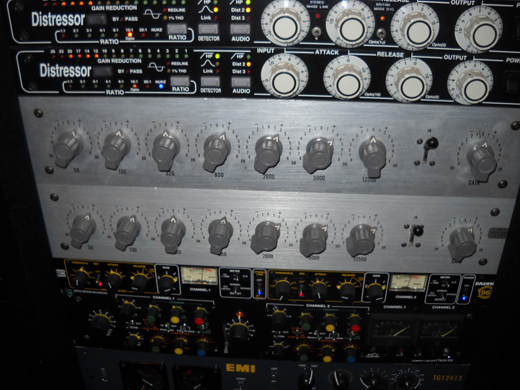
Rack One -- Motown EQ: “If you look carefully, you can still see Motown Company, MTC, on the faceplate. In Hitsville, that was their one and only EQ. I don’t know how many were made, 30 or 40, and it took me many, many years to find those two. It’s a great sound. There’s a plugin version of it, but I don’t know what they used as a model. I still like these better. It makes the kick and snare unbelievably fat. I’ll use it on bass and stereo drum loops as well. This was usually what I went to on John Mayer’s records.”
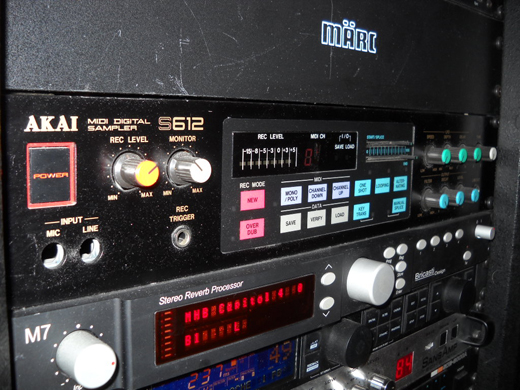
Rack Two -- Akai 612: “It’s a useless sampler, but if you go into the ‘mic in’, it just overloads it, with distortion that sounds really cool. It’s a really warm distortion. That’s one of my sends, so anytime I want to add a little bit of something – some nice, warm, harmonic distortion – I just send it to that.”
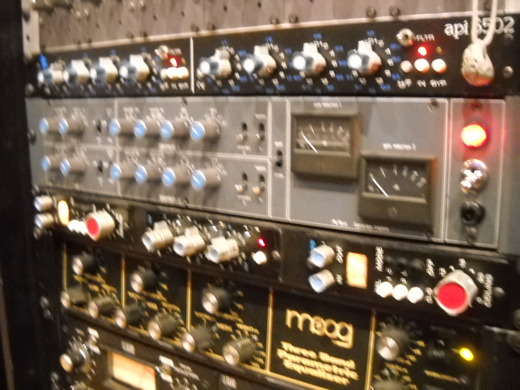
Rack Three -- Neve 33609: “This 33609 is my first-ever acquisition. It’s incredible. When I was mixing in stereo only at Media Sound, it was the Neve 33609 going in with two Pultecs behind. When the multi-buss approach doesn’t work, I’ll go to my original – everything goes to the Neve 33609 and the Pultecs. It’s a different type of glue factor that’s cool.”
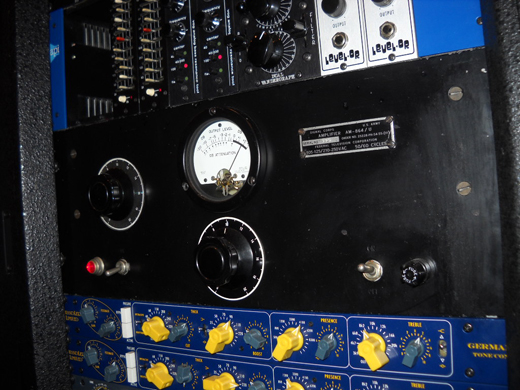
Rack Four -- Federal Compressor/Limiter: “This Federal is a great compressor that just brings the excitement out of the midrange. It’s a send return, not an insert – I don’t put it across something. I’ll send the bass, the vocals, whatever I feel like sending to it. It’s from the ‘60’s, and its got a really amazing sound.”
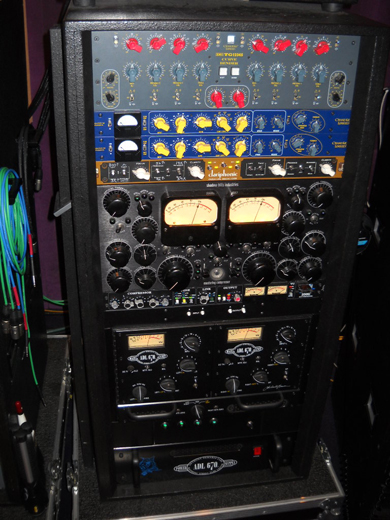
Rack Five: “That’s my mastering rack out of the stereo bus. The Chandler is germanium. The Shadow Hills is a combination of VCA or optical. Then I have this really cool-sounding 2500 API, modified by Paul Wolf who originally built API. Then I have the ADL670, a modern version of the Fairchild 670. I prefer the ADL over the original – it’s not as dark.”
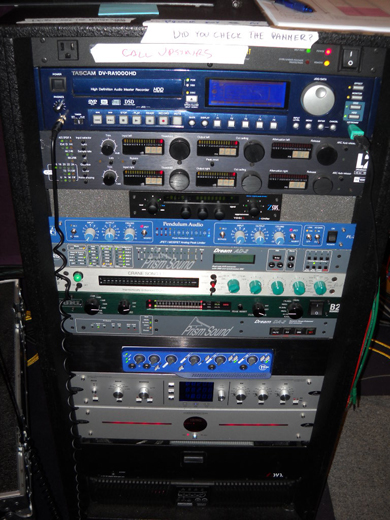
Rack Six: “The last of it is my digital rack. The final stop used to be the Studer 820, or the ATR, but I rarely use tape anymore. I have three different converters with the Prism, Crane Song, and Burl – each of them has a different sound. I always use the Antelope Atomic Clock, and I tell the mastering houses to work off one as well. If they don’t, then the width and depth of the mix will change.”
Please note: When you buy products through links on this page, we may earn an affiliate commission.







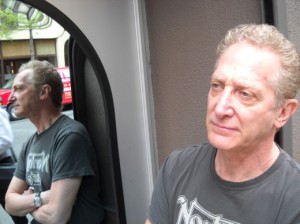
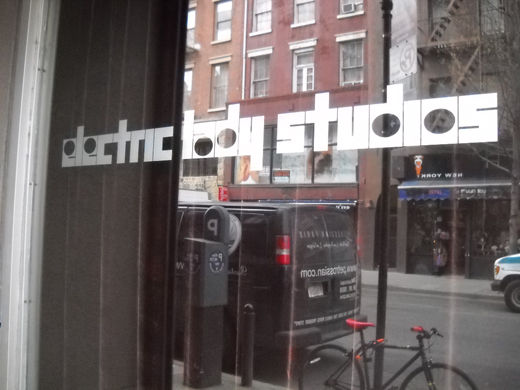

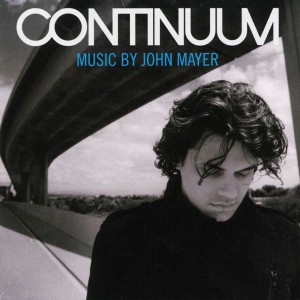

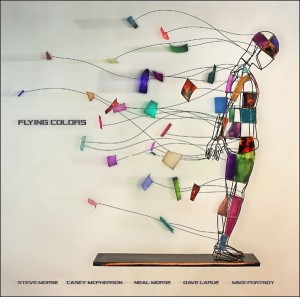
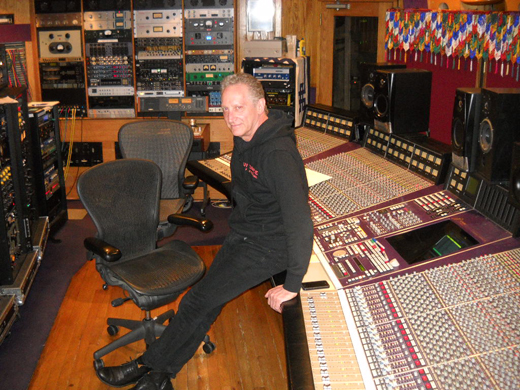
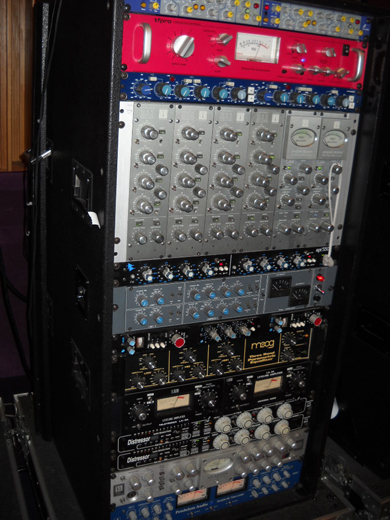
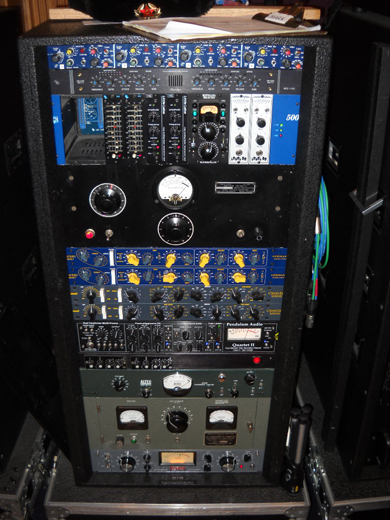
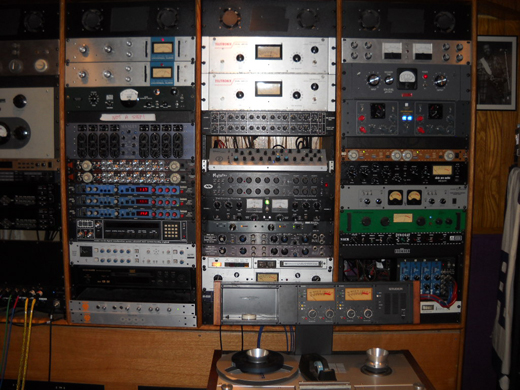
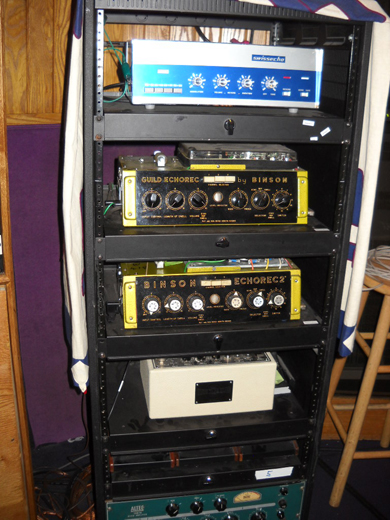
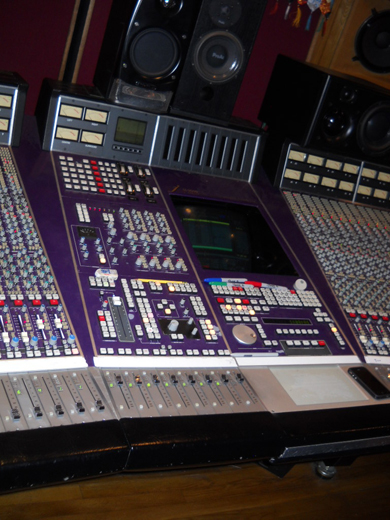
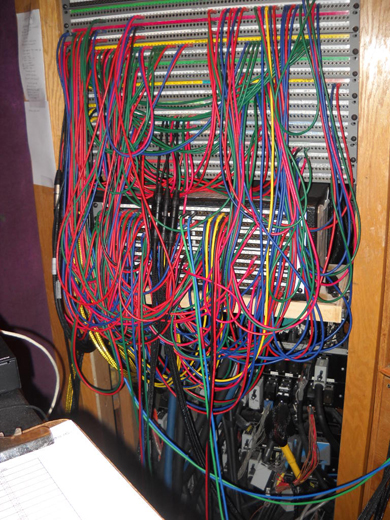
Boneshowell
April 24, 2012 at 2:39 am (13 years ago)this was a really great article. inspiring and interesting.
Jake Antelis
April 24, 2012 at 11:40 am (13 years ago)awesome!
Thejedimaster
April 25, 2012 at 2:47 am (13 years ago)Much love to you Michael…
Tonihyll
April 25, 2012 at 1:33 pm (13 years ago)Great article!
Rick Slater
April 26, 2012 at 11:44 pm (13 years ago)The fader movement in Michael’s mixes cannot be stressed enough. Things are always bouncing in his mixes.
Ularuth
April 30, 2012 at 3:57 pm (13 years ago)Great article any suggestions for mixers for a band just coming out with a first EP?
Walter Cruz
February 22, 2013 at 1:06 pm (12 years ago)Great interview. Learned a lot of things 🙂
Howard Rabach
July 22, 2014 at 6:45 pm (11 years ago)Makes me want to chuck my DAW controller and invest in a nice analog board.